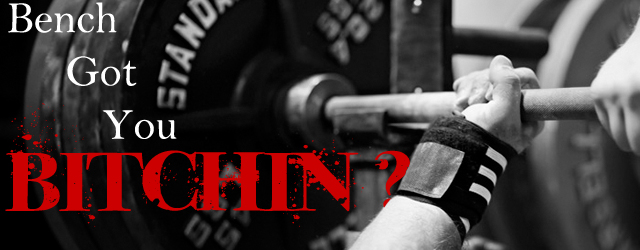
Bench Got You Bitchin’?
It's a safe assumption that most of you aren't injury free. This is particularly the case with the “Monday/Wednesday/Friday" bencher. This article covers what happens when one overuses the chest at the expense of the posterior part of the upper body.
Athletes have all sorts of issues, some minor (such as tight hamstrings) and some major (such as impingement issues), but how many of us have upper back problems such as tightness, sore spots, trigger points, and lack of mobility? I can confidently say that a majority of athletes fall into this category. Some people will attribute it to the sport and some may attribute it to how people train. All of you "Monday/Wednesday/Friday" benchers know what I’m talking about. Here's an example of why a few of you might be experiencing posterior discomfort.
I’m sure all of you at some point have stretched out a muscle that seems to be sore or extremely tight. You were probably wondering, "Why can’t I seem to get this to release?” Ever remember hearing the phrase, “to every action, there is always an equal and opposite reaction?”Well, I’m here to tell you that this could very well be the problem in your case.
How many of you feel like the guy in figure B or even maybe C? After looking at the three different figures, you can automatically assume which one experiences the least amount of discomfort. As you can see in the most exaggerated figure (figure C), this guy has extremely tight pectoral muscles. However, his upper back muscles are being forced to stretch across as his humeral head rolls forward, creating a “hump back” stature. In return, the pectoralis major muscle is shortened, increasing the anterior tilt of the scapula. I don’t know about you, but how efficient can one be with that type of shoulder position?
So now back to the phrase “to every action, there is always an equal and opposite reaction." Make any sense now? You can see why a lifter might suspect a neck or upper back problem even though T-spine mobility has a direct relationship. What else might it stem from? I can tell you right now that your pectorals have been overworked and neglected for quite some time. This not only causes an anterior roll in the humeral joint and scapula, but it also eccentrically pulls the equal and opposite conjoining muscles, as shown in the diagram below. Can you say trigger points? I feel like I just related to over 90 percent of you.
Now, you're probably saying, “Well, OK. So if I stretch my chest out, it’ll help relieve my upper back pain. What do I do now?” Well, here's a little brief on the pectoralis major muscle.
The pectoralis major muscle aids the serratus anterior muscle in drawing the scapula forward as it moves the humerus in flexion and internal rotation. Keep in mind that the pectoralis major isn't attached to the scapula, but it's effective in this type of scapula protraction because of its anterior pull on the humerus, which joins to the scapula at the glenohumeral joint.
The pectoralis major and the anterior deltoid work closely together. You're probably aware of the major use of the pectoralis muscle in push-ups, pull-ups, throwing, and overhead swings such as the tennis serve. Many of us could agree that we do those actions on a daily basis, so you can see why the term “overuse” fits too well.
Ways to improve
We all know that stretching can help us achieve some short-term relief from muscle ache, but how might you go about stretching your pectoral muscle group?
Here are a few things you can do at home to help loosen up your pectoral muscles:
- Externally rotate the shoulder with the arm at the side to stretch the entire pectoralis major. The pec doorway stretch is an easy “go to.”
- Extend the shoulder to stretch the upper pectoralis major.
- Palpate the broad area of the chest region between the clavicle and the sixth rib.
- Perform (self) manual therapy using a rubber ball or foam roller.
- Regain control over your scapula by performing T-spine mobility drills daily along with scapula tracking exercises.
Keep in mind that you won’t be able to slip away with just breaking up that tight chest. Counteracting it with a structured training program with emphasis on your posterior chain will be the best way to ensure that the problem won’t arise again. So before you go run off to your chiropractor or physical therapist, take a minute to examine yourself. You might be surprised.














1 Comment